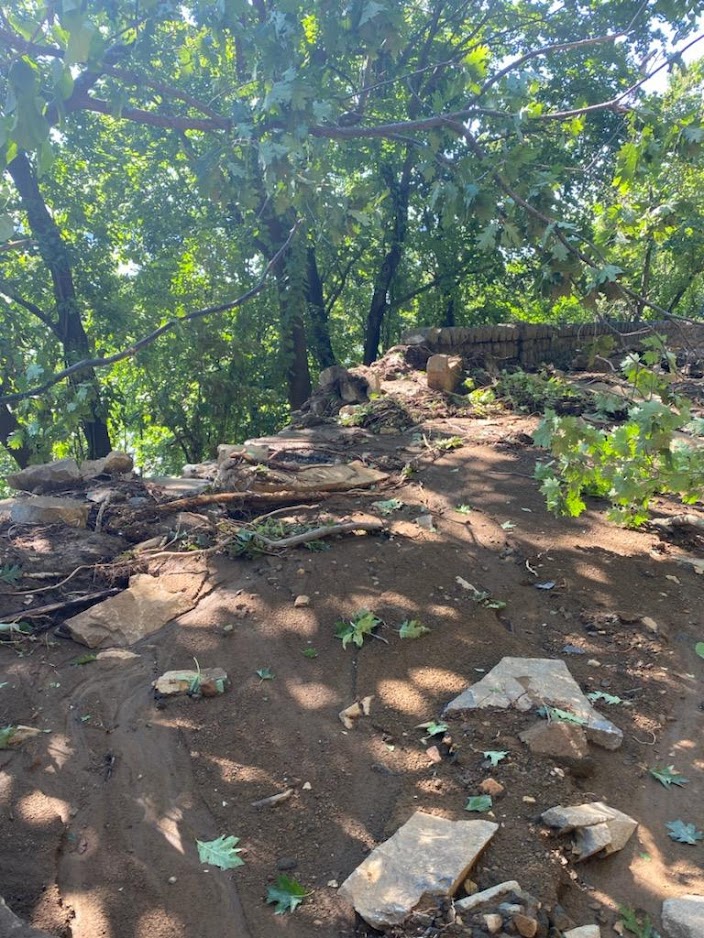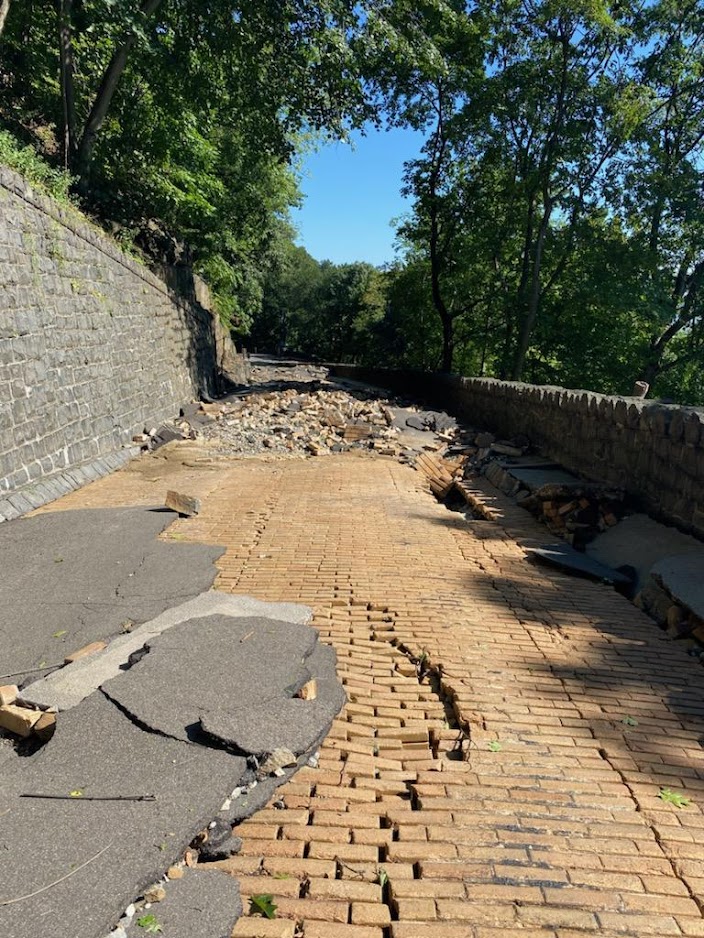Recovering from the “Big Ones”
A “Cliff Notes” Story
March 2023
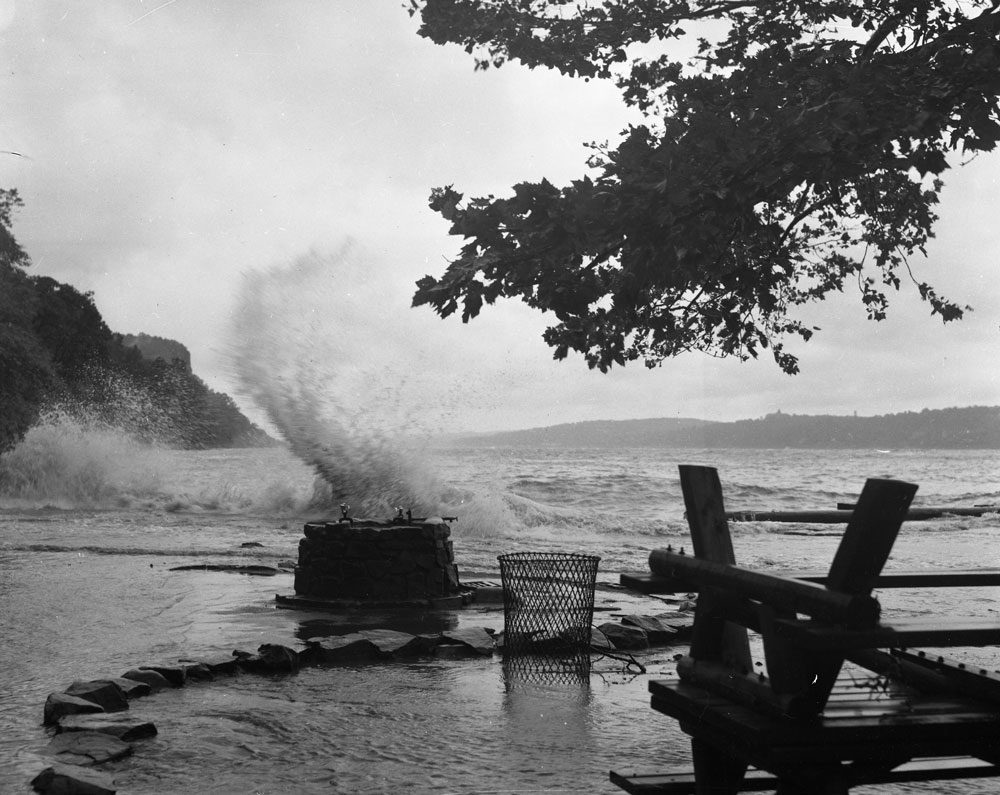
The Palisades Interstate Park has terrain that can be difficult to traverse in the best of times, and which can become impassable during storm conditions. Harder still is predicting exactly where each storm will hit the most along our twelve miles of riverfront, roads, and steep cliffs. Cleanup takes a massive effort in the best of conditions, but once you factor in the structural integrity of parking lots, public facilities, and roadways, the work quickly adds up. This is why it is dangerous to enter the park when signs note that it is closed, because usually that means there is a situation that will put someone at risk.
The remnants of Hurricane Ida in September 2021 brought unprecedented amounts of rain that closed sections of the park and made entire roads unusable. Flash flooding was so forceful that asphalt from Dyckman Hill Road was peeled off, and Henry Hudson Drive had rockslides and other debris across much of its entire length. More than a year later, Dyckman Hill Road remains closed, with the original brickwork from the first iteration of the Park Commission’s paving in the early 1900s still exposed. In the aftermath, as we rebuild, many visitors approach us to inquire when damaged park sections will be reopen. We do our best to answer questions, but sometimes there are so many variables involved, it is hard to know exactly when these areas will be safe for the public.
North Jersey is not known for its devastating weather, but we have had our fair share of large storms. The Palisades, towering to over 500 feet, provide some protection to Northern Valley watersheds during extreme weather events. The major concerns inland are Nor'easters, and larger flash floods due to precipitation. But, that protection for the surrounding towns means our park’s riverfront often takes the brunt of storm damage during major ocean flooding events. This has resulted in historic levels of destruction and is a main reason it takes us so long to recover after a "Big One" hits.
Hurricane Sandy in 2012 is now infamous, having brought damage to boat basins, picnic areas, and even the Historic Kearney House. In the more than 250 years that the house has stood beside the Hudson, Sandy caused the worst damage we know of. Over four feet of water inundated the structure, and repairs were extensive. We are now eleven years post-Sandy, and still we feel its impacts in how we operate our boat basins, and how we prepare for future disasters
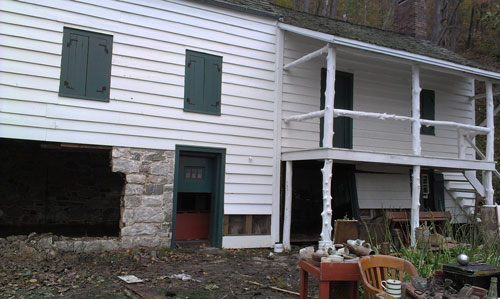
There were many things which contributed to Sandy’s “perfect storm,” including both human activity and natural occurrences. Right as the storm hit, it was a full-moon tide, or “Spring Tide.” This is the highest a tide will get due to the gravitational influence of the moon on our oceans. An exceptionally high tide made for higher storm surges, resulting in the damage to buildings and park facilities. Other contributing factors included human overdevelopment of coastlines, meaning that storm waters had nowhere to be absorbed into: Watersheds such as those found at the Meadowlands need to be healthy sponges able to take in water during these natural events.
Although big storms and extreme weather have always been a part of our history, these exceptional weather patterns are occurring with increasing regularity. Along with this, our parking lots flood due to tidal activity almost every full and new moon now, when historically they rarely did. Monthly parking lot flooding causes many to comment on what they are seeing firsthand. Workers who have been with us for over 30 years note that this “Blue-Sky Flooding” is clearly getting worse — sections that would only get submerge during storms are now inundated during normal full-moon tides. Even in sunny weather, we are seeing this trend. It might be logical, then, to think that our parking lots are the issue, perhaps they are deteriorating or new dredging right along the river needs to be done to clear debris? Yet this is not just a problem at one or two sections of the park, but along the entire riverfront. Hikers along the Shore Trail now must contend with mud and navigate flooded trails during these higher tides, which rarely reached so far inland in the past. Any parks adjacent to the Hudson or along the ocean now must prepare for these rising tides.
So what is happening? The Palisades Interstate Park in New Jersey has twelve miles of shoreline, and we want to know exactly what is different now from the last 120 years of our existence. One place we can turn for answers is to NASA and satellite data.
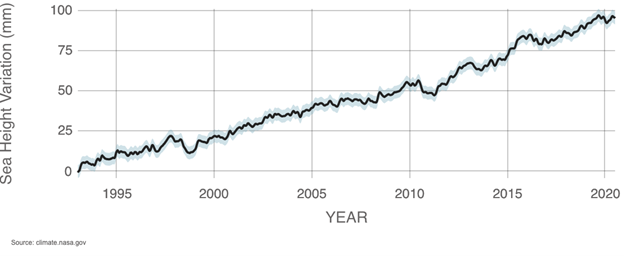
The New Jersey coastline has had to adapt to sea levels rising about 12 inches since 1950. With these concerns, along with other human activity, it seems that “Once-a-Century” storms are happening more as the impacts of Climate Change continue to shape our coast. Two billion dollars have been spent on storm repair due to sea level rise in New Jersey alone. 45,000 developed properties are at risk of coastal flooding currently. Global temperatures are changing at a more dramatic rate than they have in the last 3 million years.
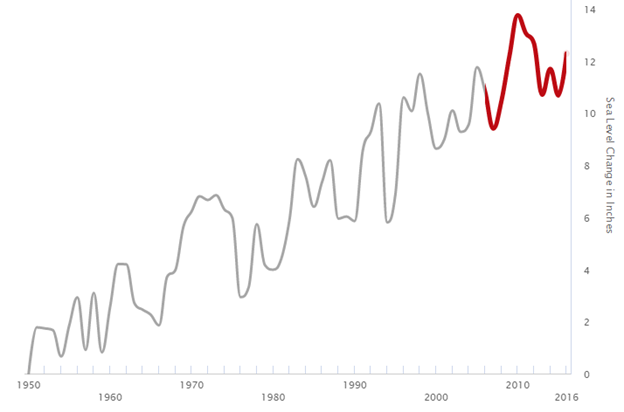
Disaster recovery is a giant process and has always been a part of our park. For instance, in 1933 the park set aside $4,127 for repairing “storm ravages” (around $92,600 in 2022 dollars). By 1945 a hurricane hit that cost $9,953 in fallen trees and boat basin damage ($162,000 in 2022). Years after the initial damage, this storm was referenced in our Annual Reports, showing how long-lived these events could be.
By 1950, a windstorm caused enormous damage, causing $13,349 worth of damage (or today’s $158,200). As described in the records:
The storm of November 25th, 1950 created more havoc in the Park than any previous storm since the Park was established. As a result of this storm, 12 miles of the shore road was heavily damaged; the Alpine Boat Basin was wrecked and approximately 350 feet of boardwalk at the Englewood Basin torn out; docks along the waterfront sustained heavy damage; the racks and foundations at the Old Englewood Ferry Terminal and the Pavillions at the Englewood-Bloomers area were considerably weakened; between six and seven thousand trees were blown down and many of the Park buildings sustained damage to their roofs and, in some cases, smaller buildings were completely demolished. While it may take several years to overcome all the effects of this storm, the Maintenance Department did an excellent job in getting the Park reopened at the beginning of the summer season in 1951. A Contractor is still working on the clean-up of the down timber in the Park area on top of the Palisades.
Today’s repair costs are in the millions. Hurricane Sandy (2012) cost the park over a million dollars and we only just recently finished the paperwork in the aftermath. Hurricane Ida (2021) has put an extreme strain on our resources as well. Though we always have suffered storms, it is clear the damage is getting worse both physically to our facilities and financially during cleanup efforts. Though they are the most dramatic events we see, storms haven’t been the Palisades’ only concern.
In an annual report from five years later, the Park explained:
The summer of 1955 was one of the hottest and driest six-week periods on record. The season was brought to a crashing end by hurricanes CONNIE and DIANE, which occurred on August 13th and 17th, respectively. Bathing facilities were in great demand as a result of the hot and dry summer. There being no such facilities in the New Jersey section because of the pollution in the Hudson River, visitors arriving at the Park, especially on Sundays and holidays, were directed to the new facilities in the New York section…
Since World War II, the Hudson River was far too polluted to allow bathing beaches to run in the Palisades. These environmental catastrophes were a direct consequence of factories upriver dumping contaminants directly into the waters. As regulations have largely curtailed this practice, the river has become far cleaner. Every year, the Hudson continues to become a more habitable place for a healthy ecosystem. As for the record-breaking Summer of 1955, NOAA recently released a statement that 2022 was the hottest year on record for the world since recording began in the 1800’s. The last 6 years have been record-breaking, meaning that the Earth is getting warmer. So, we are seeing record-breaking conditions from local water levels, to repair costs, to global temperatures.
Human activity is spurring on extreme impacts of climate change. As more ice melts, oceans have more fresh water, which in turn is warmed and joins our atmosphere. With more “ammo” in storms, they become more extreme. In our future lurks plenty more superstorms, just like Ida.
Climate Change is just that— we will see more extreme weather fluctuations, different weather trends, and unpredictable animal and plant activity as they are forced to adapt far faster than their evolutionary ancestors. The bright side? A human problem will require a human solution. Just as we once spoke out and cleaned up the Hudson River, we have a chance to limit the impacts of Climate Change in its many forms. Human-driven changes can be reversed. So as we take time to recover in our neck of the woods from storm damage, make sure you learn about how other areas are being impacted by this global crisis
– Francesca Costa –


